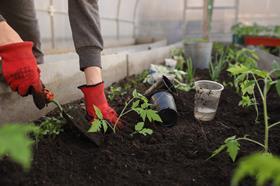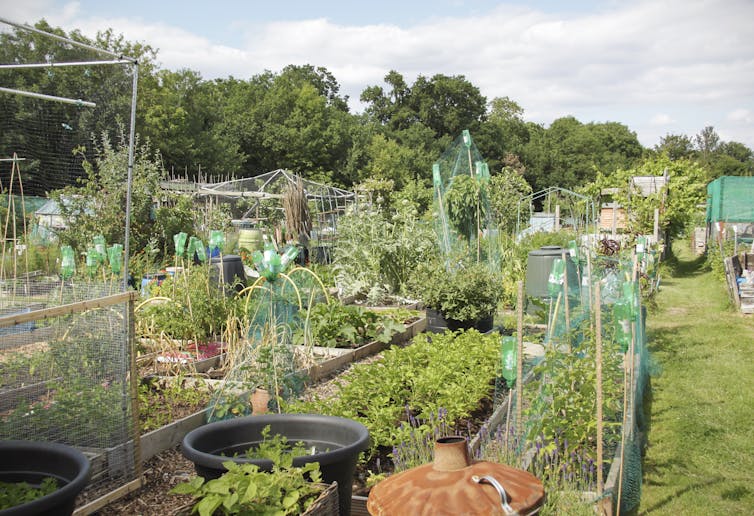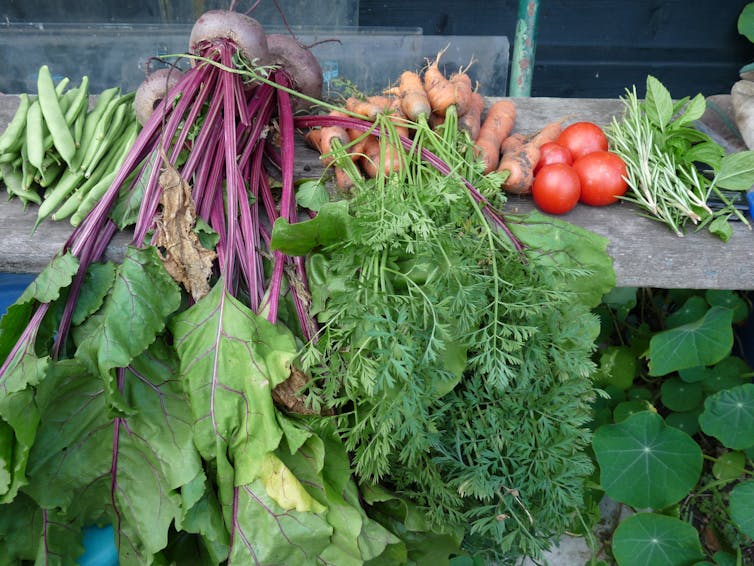
A supply of fresh fruit and vegetables is crucial to a healthy nation – and to building a food system that makes us well instead of sick.
The recent target of a 30 per cent increase in fruit and vegetable consumption in the UK by 2032, set last year by the independent National Food Strategy review, means we need to consider how these fruit and veg can be grown sustainably: and how we can encourage people to eat more of them.
Urban horticulture is a largely overlooked way of providing fresh, high-quality food to city dwellers by producing fruit and vegetables within cities, that has historically been vital for the UK’s food supply.
During the second world war, as part of the government’s ‘Dig for Victory’ gardening campaign, 18per cent of the fruit and vegetables eaten by UK citizens were grown domestically in allotments and gardens. Yet in 2018, that figure was just 3 per cent.
 Allotments are commonly used to grow fruit and vegetables.Kotomi_/Flickr, CC BY-ND
Allotments are commonly used to grow fruit and vegetables.Kotomi_/Flickr, CC BY-ND
With 84 per cent of the UK population now living in cities and towns, as a nation we’ve become largely detached from the practice or possibility of growing our own food.
But there’s more and more evidence to suggest that reviving this practice could be the key to shoring up our food security against threats like climate change, supply chain breakdowns and disease.
Five a day
Just over a quarter of the UK population actually eat ‘five a day’: the number of portions of fruit and vegetables the World Health Organization recommends adults consume.
This is linked to income: the richest 20 per cent of the population eats on average one portion more of vegetables per day compared to the poorest 20 per cent. And the consequences are serious: a diet lacking in fresh fruit and veg can increase the risk of stroke, heart disease and some cancers.
If we are to address these inequalities, we need to create an equal food environment. Promoting urban horticulture could help achieve this by putting fruit and vegetable production back at the heart and in the hands of local communities.
Commercially grown fruit and vegetable crops in the UK provide just over half of the vegetables and under 20per cent of the fruit we eat from a very small area of land – equivalent to 23m² per person.
Recent research carried out in Sheffield found that there was the equivalent of approximately 97m² per person in the city that could potentially be used for growing fruit and vegetables. That’s enough land to feed over 120 per cent of the Sheffield population following a five-a-day diet.
Not all of this land should or could be used for growing food. The pandemic has demonstrated the numerous benefits to health and wellbeing of providing people with green spaces.
But if just 10per cent of this available land was used for growing fruit and vegetables, when combined with existing allotments in Sheffield, there would be enough growing space to feed 15per cent of the population five portions of fruit and veg a day.
This would be a big increase on the estimated 3 per cent of Sheffield’s population currently fed on five a day from urban allotments.
In 2018/19, 3.0 per cent of fresh fruit and vegetables entering the household came from free sources, mainly gardens and allotments.
 Food can be grown with little space or light using techniques like hydroponics.Loopzilla/Flickr, CC BY-SA
Food can be grown with little space or light using techniques like hydroponics.Loopzilla/Flickr, CC BY-SA
What’s more, growing food in cities doesn’t have to be confined to green spaces. Technological advancements in soil-free growing, such as hydroponics systems, allow people to grow produce on rooftops in cities or in disused buildings without natural light.
Expanding fruit and vegetable production in cities could also reduce pressure on high quality agricultural land typically used to grow crops, freeing up more of it for rewilding and carbon storage.
Community spirit
Shifting fruit and vegetable production into cities also offers a cultural challenge around how to encourage more urban dwellers to grow their own food: which means understanding the barriers that put people off.
At Sheffield’s Institute for Sustainable Food, we’re calling on the government to do more to engage urban communities with growing through funding community and school gardens, allotments and hyperlocal farms focused on very specific areas.
This could result in a patchwork of food growing regions across cities that, in time, become an integral part of the UK food system.
If this comes to fruition, we can expect to see health and wellbeing benefits across the board – not just thanks to more nutritious diets, but also because of the dramatic improvements in well-being that belonging to an active community can bring.![]()
This article is byJill Edmondson, Research Fellow in Environmental Change,University of Sheffield andSamantha Caton, Senior Lecturer in Health,University of Sheffield. It is republished from The Conversation under a Creative Commons license. Read the original article.



